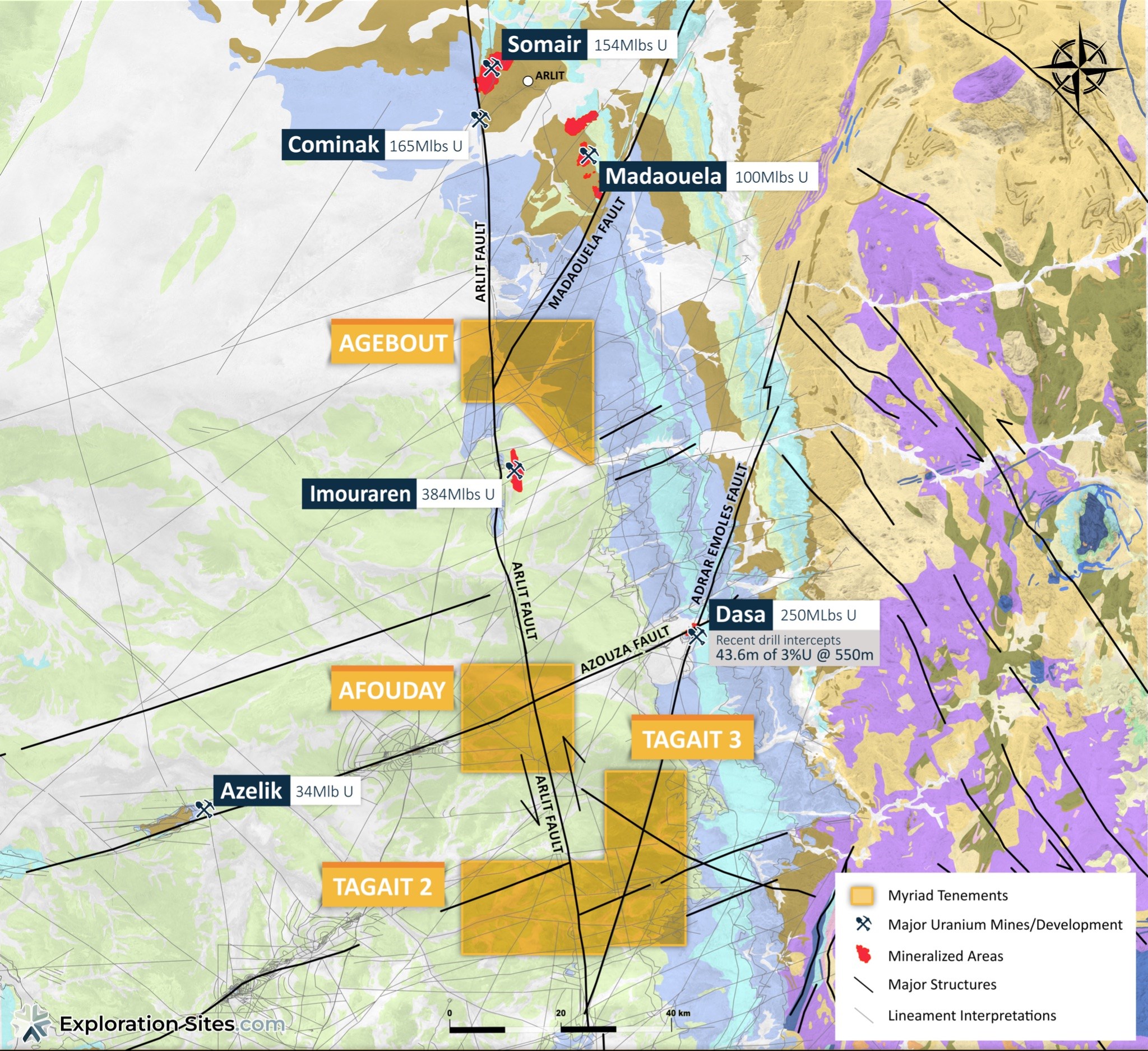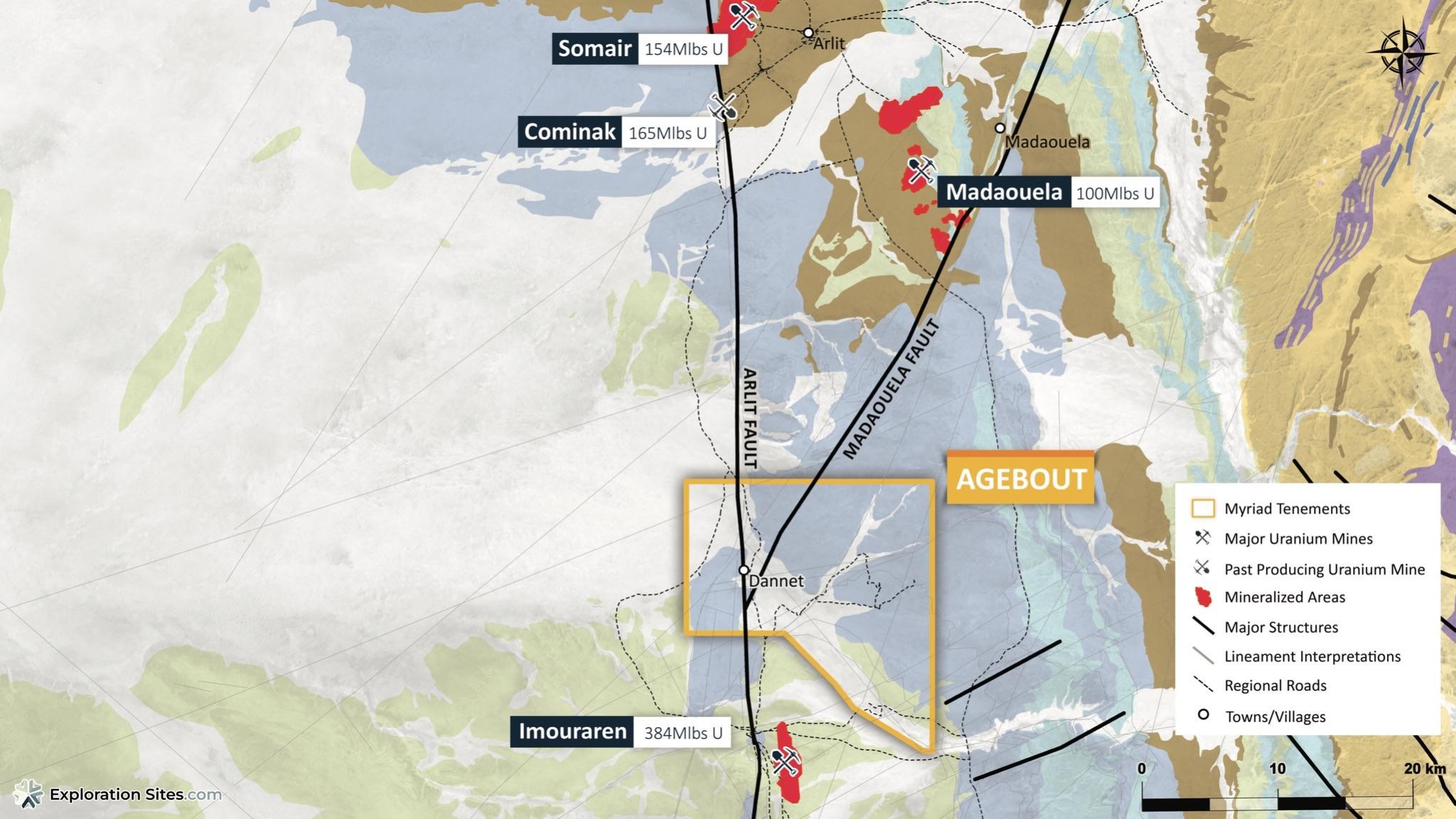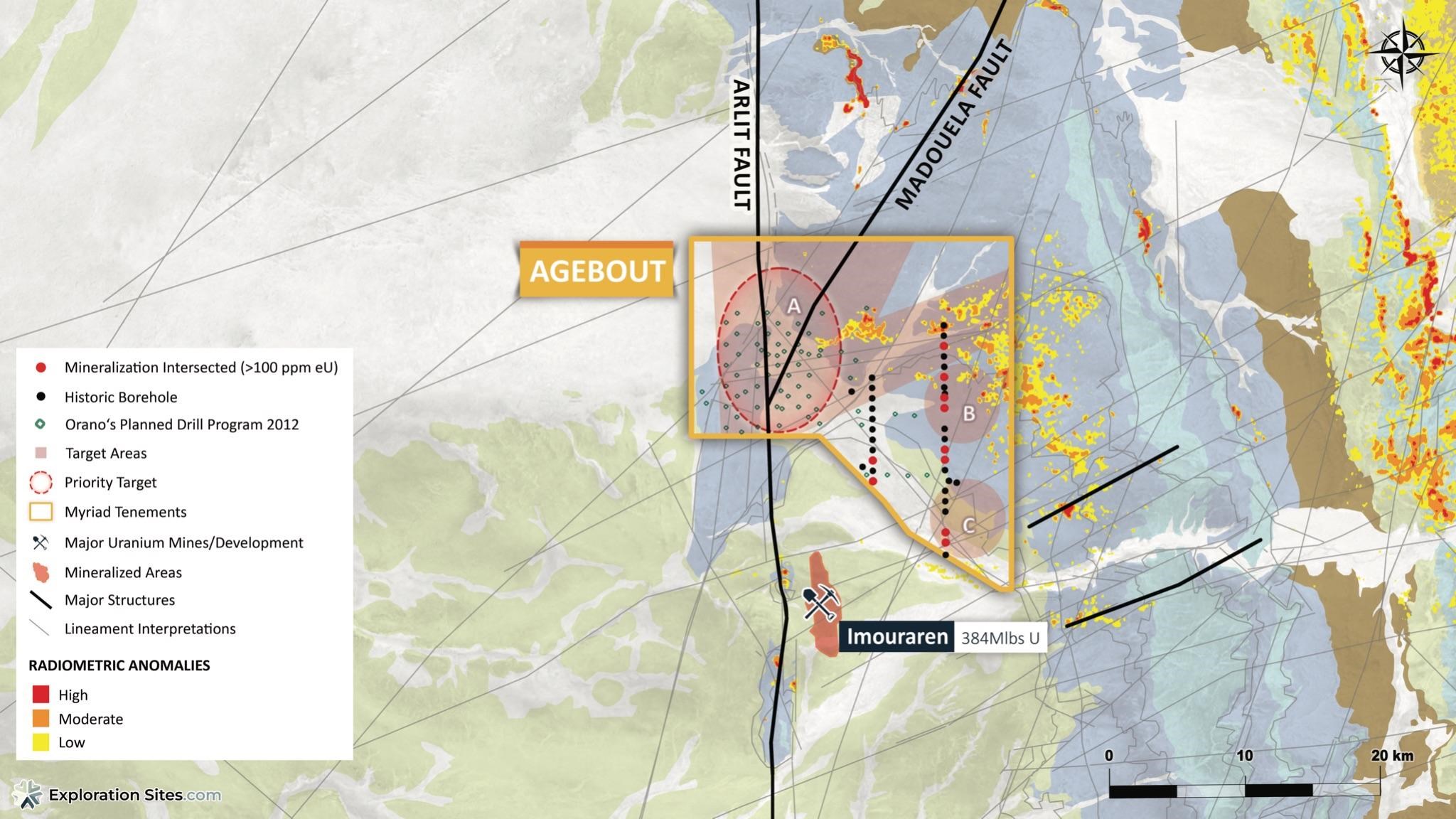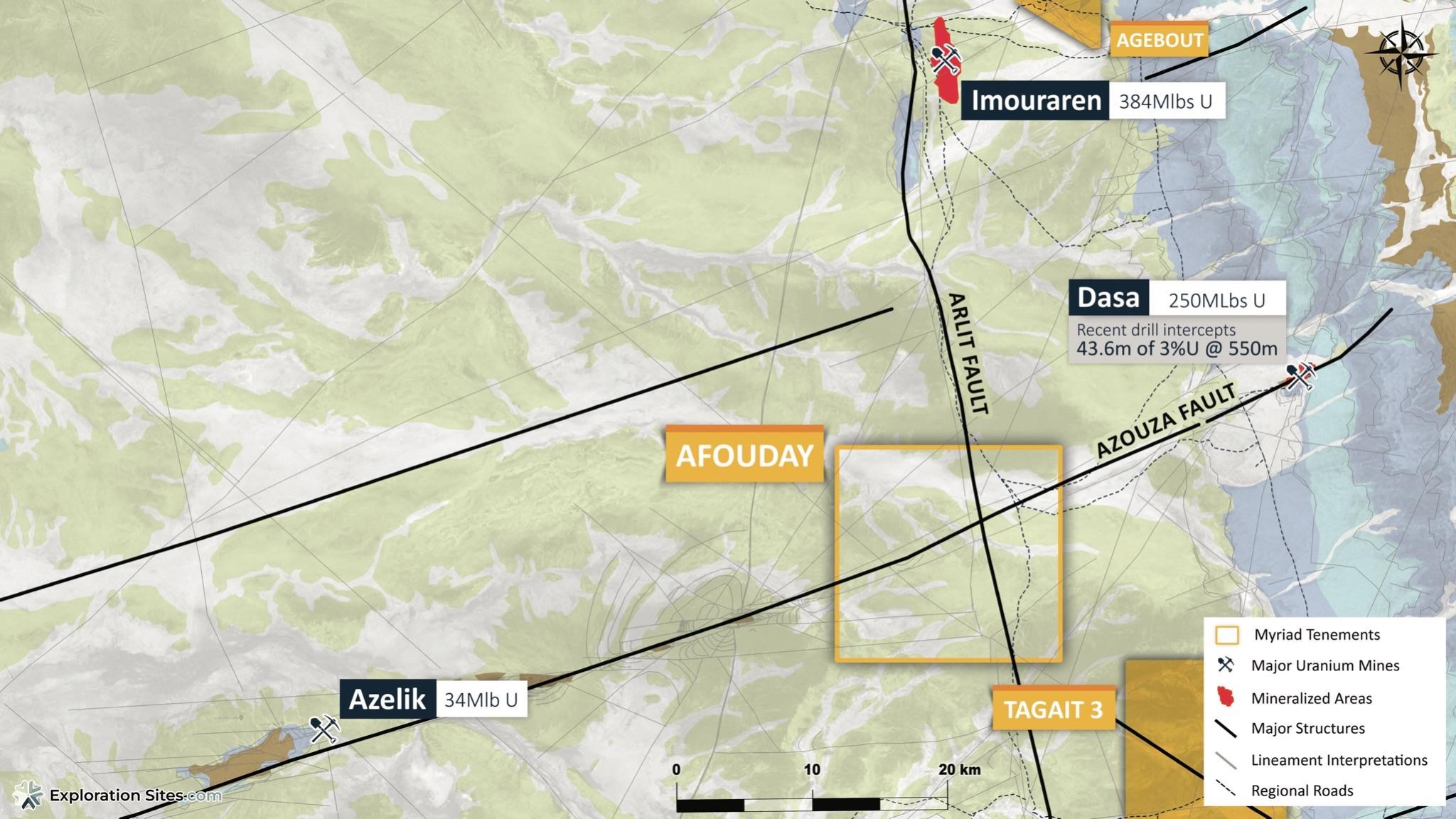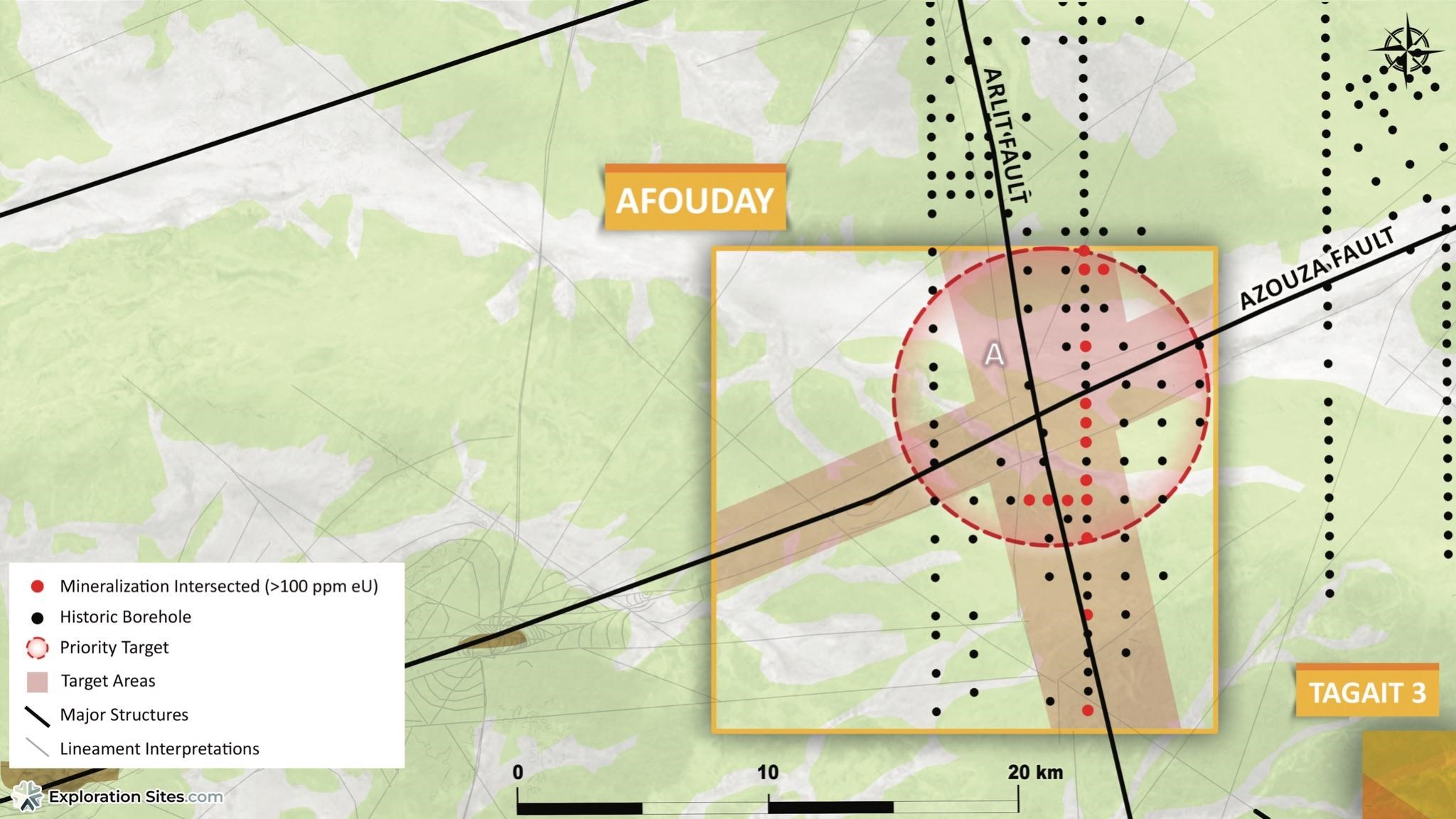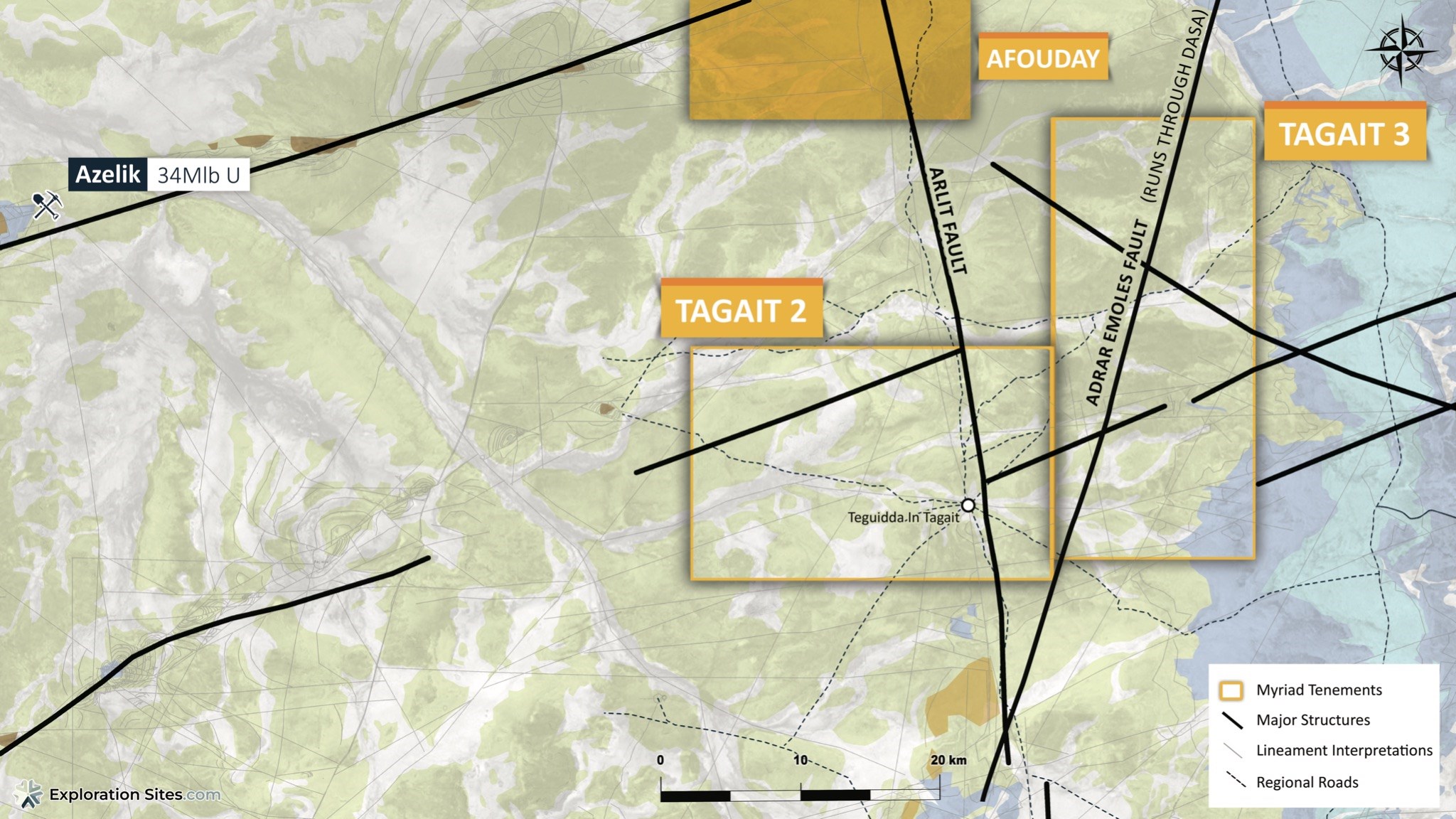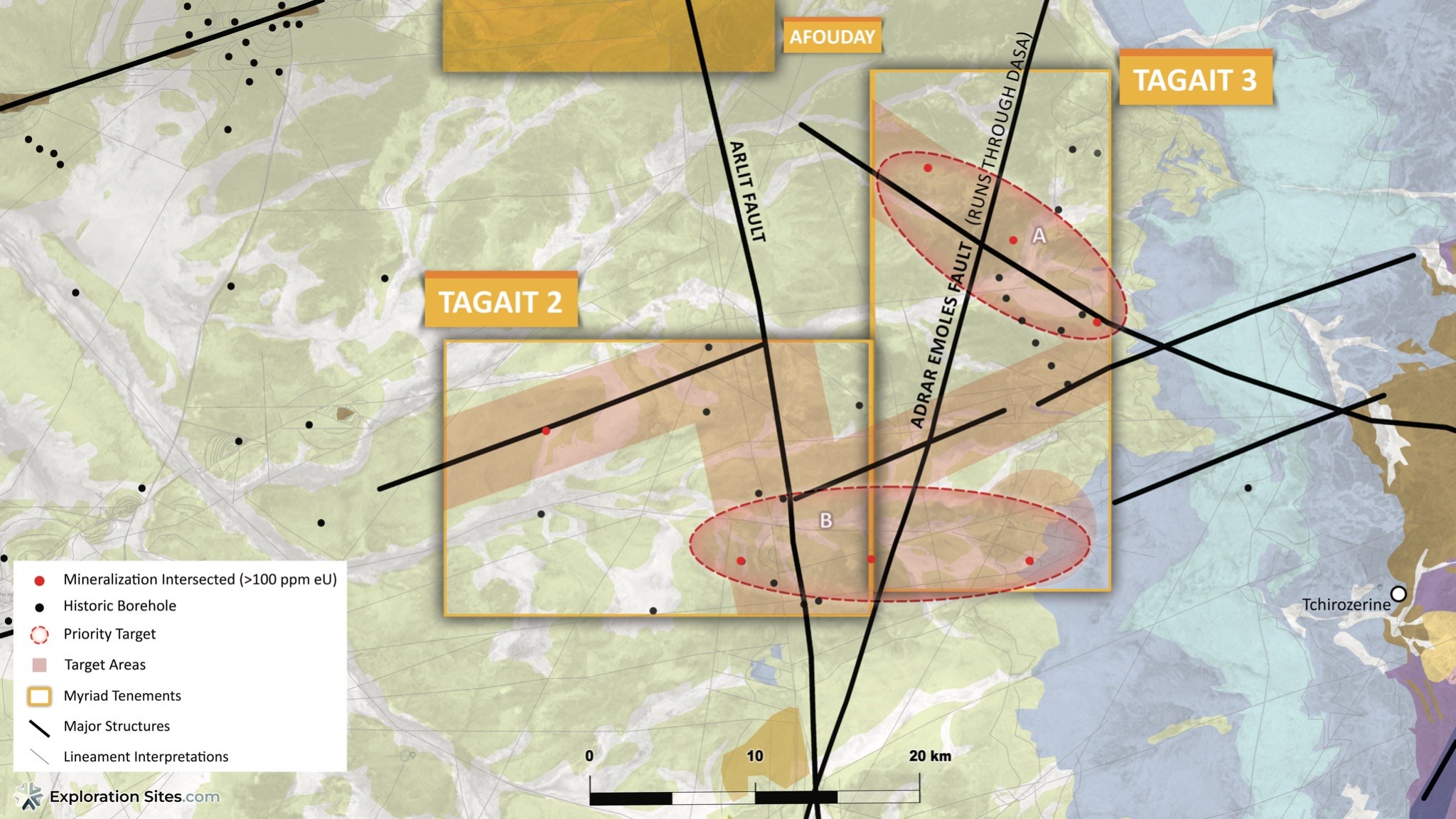Myriad Uranium Is Positioned to Make Major Discoveries
Vancouver, British Columbia–(Newsfile Corp. – January 9, 2023) – MYRIAD URANIUM CORP. (CSE: M) (“Myriad” or the “Company“) is pleased to provide the following update.
“We are a new uranium explorer with an enormous land package covering key locations in the Tim Mersoï Basin, Niger,” stated Thomas Lamb, CEO. “Over the past several months we have worked hard to identify, obtain, and review extensive historic data relating to Orano’s (and its predecessors’) previous exploration of these areas. I am pleased to report that after our initial review, we have identified a number of high priority targets. This is a massive head start, and we are now even more excited about our young Company’s future. This news release discusses what we have learned and the exciting path ahead, which we hope will lead to the Company making major uranium discoveries in Niger.”
Highlights
- Myriad holds 100% option interests in over 1,800 km2 of exploration licences on-structure and near several of Africa’s (and the world’s) most significant uranium deposits, including Dasa, Imouraren, Azelik, Sominak, and Comair.
- Orano (or its predecessors) previously engaged in significant regional-scale exploration of Myriad’s licence areas, which included at least 161 boreholes, airborne and ground geophysics, geological mapping, and seismic surveys.
- Myriad has obtained much of the data relating to this previous work, giving the Company the benefit of millions of dollars of quality work by one of the world’s leading uranium companies.
- Approximately 20% of the historical boreholes within Myriad’s licence areas intersected significant (at least 100 ppm eU) mineralization.
- All Myriad licences show important structural dihedrals defined by the major faults that control uranium mineralization (as shown in multiple figures below).
- Myriad will leverage recent discoveries in the Tim Mersoï Basin, in particular Global Atomic’s Dasa, which has revealed that very high uranium grades also lie in secondary fault structures and at depths not previously investigated.
- The Company has a world-class technical team led by George van der Walt and will now build on a wellspring of historical information, with a goal of drilling in 2023.
* Mineralization hosted on adjacent or nearby properties is not necessarily indicative of mineralization hosted on the Company’s properties.
Background
Myriad holds 100% option interests in over 1,800 km² of exploration licences in the Tim Mersoï Basin, Niger, one of the world’s most prospective uranium districts. The Company’s four licenses (Agebout, Afouday, Tagait 2, and Tagait 3) are immediately adjacent to or within 25-50 kilometres of some of the world’s most significant uranium deposits. See Figure 1.
All four of Myriad’s licences were previously held by Orano (reference to Orano includes its predecessor entities such as Areva and Cogema). Orano dropped claims throughout the Tim Mersoï Basin in and around 2013, in the aftermath of the Fukushima accident and during a period of extremely low uranium prices. However, throughout this period Orano did continue to focus on its “mine of the future” (and Africa’s largest uranium deposit at 380 Mlbs eU₃O₈), Imouraren.
To view an enhanced version of Figure 1, please visit:
https://images.newsfilecorp.com/files/6301/150652_1dfa7675d4a60bf1_001full.jpg
Uranium mineralization within the Basin is related to roll-front style deposition in westerly-dipping sandstone formations, but is strongly controlled by regional structures, particularly the major north-south trending Arlit Fault, along which most of the major deposits are located. This includes Imouraren, Cominak, and Somair.
In recent years it has been discovered that major deposits can also be found along secondary fault structures, such as the Dasa and Madaouela deposits, which lie on the Azouza, Adrar Emoles and Madaouela Faults. See Figure 1 above. At combined resources of over 250 Mlbs eU₃O₈, Dasa is not only very large, but it is also currently the highest grade uranium project under development in Africa. Dasa’s owner, Global Atomic, recently reported remarkably high exploration grades, such as 43.6 m at 3.0% eU₃O₈ from 549.2 m, which contained 4.48 m at 6.38%, 0.7 m at 13.63%, and 3.4 m at 7.48%.
Before insights from the Dasa discovery were available, Orano engaged in regional scale exploration of the ground covered by Myriad’s licences, generating a significant amount of data. In aggregate across Myriad’s licences, Orano’s exploration included at least 161 boreholes, geophysics, geological mapping, and both seismic and surface radiometric surveys. Myriad has obtained much of this data and has conducted an initial review.
The data has directed the Company to several high priority target areas where additional Dasa-and- Imouraren-like discoveries are possible, as described in further detail below. Unlike Orano, Myriad now enjoys the benefit of higher uranium prices, which makes previous work by Orano, perhaps not considered as interesting 10 years ago, much more interesting now. Myriad can also leverage recent discoveries in the Tim Mersoï Basin, in particular Global Atomic’s Dasa, which has revealed that very high uranium grades can also be found in secondary fault structures adjacent to the main Arlit fault, and at depths not previously investigated, which leaves some highly interesting “gaps” in Orano’s previous exploration work on our licences.
Agebout
The Arlit and Madaouela Faults intersect within Agebout approximately 10 km north of Orano’s “mine of the future”, Imouraren – See Figure 2 below. This is regarded as a prime target for further exploration. Orano had themselves previously developed a plan to conduct intensive drilling in the area, but abandoned it post-Fukushima as a part of Orano’s larger strategy to cut back on licence areas and focus on Imouraren. Myriad now holds this area and will have an opportunity to test Orano’s planned exploration strategy.
To view an enhanced version of Figure 2, please visit:
https://images.newsfilecorp.com/files/6301/150652_1dfa7675d4a60bf1_002full.jpg
Further east within Agebout, Orano’s radiometric surveys identified numerous surface anomalies. Orano conducted wide-spaced drilling in this area, consisting of 39 boreholes at 800 m centres along 5.5 km spaced lines, specifically targeting locations around surface anomalies. The known major fault zones were not fully tested, nevertheless 10 of those boreholes intersected mineralized intervals in excess of 100 ppm eU. Note that Orano used a uranium reporting standard developed by the French Atomic Energy Commission (defined as “AVP c/s”) to report uranium grades internally and although we have original downhole natural gamma measurement logs, we have not yet identified the appropriate conversion factors to report equivalent uranium grades from these measurements. Historical drill logs were used to identify anomalous holes and depths, but Myriad will not speculate on grades beyond that without first conducting verification logging.
Taking into account more recent insights regarding mineralization in the Tim Mersoï Basin, in particular that high grade mineralization may occur in deeper stratigraphic horizons, the south-east part of Agebout also represents a prime targeting location. See Figure 3 below.
To view an enhanced version of Figure 3, please visit:
https://images.newsfilecorp.com/files/6301/150652_1dfa7675d4a60bf1_003full.jpg
Afouday
Two of the most important faults in the Tim Mersoï Basin, the Arlit and Azouza Faults, intersect within Myriad’s Afouday licence. The Arlit Fault hosts the Imouraren deposit, located 50 km to the north, while the Azouza Fault (where it meets the Adrar Emoles Fault) hosts the Dasa deposit, located 30 km to the north-east, and the Azilek deposit, located 55 km to the south-west. See Figure 4 below.
To view an enhanced version of Figure 4, please visit:
https://images.newsfilecorp.com/files/6301/150652_1dfa7675d4a60bf1_004full.jpg
The intersection of the Arlit and Azouza Faults is regarded as a prime targeting location as indicated in Figure 5 below.
To view an enhanced version of Figure 5, please visit:
https://images.newsfilecorp.com/files/6301/150652_1dfa7675d4a60bf1_005full.jpg
This area saw significant exploration until 2010. Orano conducted relatively shallow wide-spaced drilling of 94 boreholes at 800 m centres along 1.5 km (and wider) spaced lines in the eastern half of the property. Prime locations along the known major fault zones, particularly Azouza, were not fully tested, nor were any of the holes drilled to a depth where later high-grade intercepts were found at Dasa (see Figure 4 above), with intercepts as high as 0.7 m at 13.63% eU₃O₈ at 551 m. Nevertheless, 15 of the historical boreholes intersected mineralized intervals in excess of 100 ppm eU, with the frequency of uranium occurrences seeming to increase with depth.
Tagait 2 and Tagait 3
The Tagait 2 and 3 properties are immediately adjacent to each other and located approximately 25 km south and south-east of the Afouday property. The Arlit Fault intersects on Tagait 2 with other potentially significant faults, and as we have recently learned from discoveries at Dasa and elsewhere, secondary faults running away from Arlit should not be overlooked as potential exploration targets. On Tagait 3, the Adrar Emoles Fault also forms structural dihedrals, which should be considered prospective. See Figure
6 below.
To view an enhanced version of Figure 6, please visit:
https://images.newsfilecorp.com/files/6301/150652_1dfa7675d4a60bf1_006full.jpg
Limited historic drilling was done on these properties in the 1960’s, with 12 boreholes recorded on Tagait 2 and 16 boreholes recorded on Tagait 3. Any planned activities of Orano to conduct further exploration at Tagait 2 and Tagait 3 were interrupted by the decision of Orano to relinquish a number of its Niger exploration licences following the Fukushima disaster.
Historic data obtained by Myriad indicates that at least 11 of the 28 boreholes encountered mineralization in excess of 100 ppm eU. Of particular interest are three consecutive anomalous boreholes running along a north-west to south-east fault in Tagait 3, circled in Figure 7 below.
The Tagait licences are geologically very interesting and, like the other areas, represent largely underexplored terrain (each Tagait licence is over 400 km² in extent). Tagait 2 and Tagait 3 are respectively traversed by the Arlit and Adrar Emoles faults. Moreover, several secondary faults which run through both licence areas host significant deposits to the west and south-east of the Tagait licence boundaries. Quite simply, this is exciting ground that needs to be explored further.
Myriad has identified primary targets within Tagait 2 and Tagait 3 as indicated in Figure 7.
To view an enhanced version of Figure 7, please visit:
https://images.newsfilecorp.com/files/6301/150652_1dfa7675d4a60bf1_007full.jpg
The Road Ahead
Myriad is currently developing a phased exploration plan, which is anticipated to include:
Current – Q1 2023
- Further examination and analysis of historic data.
- Field-based confirmation of surface radiation anomalies and related geologic observations
(currently underway). - Construction of more detailed geologic maps and cross sections from existing data to identify and
constrain the target horizons and depths.
Q2 2023 – Q3 2023
- Possible high resolution magnetic geophysical surveys to better constrain the primary fault
locations for drill targeting. - Surveying selected historic boreholes to confirm previous uranium occurrences.
Q4 2023
- Reconnaissance test drilling at selected locations based on assessment of the data.
2024 and beyond
- Target and resource delineation drilling, based on success of the earlier phases.
Thomas Lamb, CEO, stated, “Myriad has significant advantages which give it real potential to make world-class discoveries. First, the Company holds 100% option interests in a very large land package, on-structure to and near several of Africa’s (and the world’s) most significant uranium deposits. Second, the Company’s areas have seen extensive regional-scale exploration by one of the world’s leading uranium companies, Orano, and we have obtained much of the data relating to that work. Third, based on our initial review of the data, it appears approximately 20% of historical drill holes in the Company’s licence areas intersected significant (at least 100 ppm eU) mineralization. Fourth, more recent discoveries in the Tim Mersoï Basin – in particular Global Atomic’s Dasa – have informed explorers about additional faults (beyond Arlit) that may control mineralization, and that higher grade mineralization in the Basin can occur at deeper strata than previously investigated. Fifth, we have learned about past drill programs conceived by Orano to intensify exploration at high priority targets within our licences that were never executed in the wake of the Fukushima accident. Finally, and critically, we are fortunate to have been able to launch as a uranium explorer with a world-class technical team led by George van der Walt.”
Myriad’s Technical Team
Myriad is building the international and in-country technical team needed to make major discoveries. It is led by George van der Walt who holds the role of Geological Operations Manager at The MSA Group. Mr. van der Walt holds a MSc. in Economic Geology from the University of the Witwatersrand and is a registered professional geologist (Pr.Sci.Nat.) with over 18 years’ multicommodity experience. He has extensive uranium exploration experience, having excelled as Exploration Manager for Peninsula Energy’s Karoo extensive uranium projects in South Africa, during which time he implemented technical supervision of all exploration, pre-feasibility, due diligence and site rehabilitation activities for large project areas and a database in excess of 12,000 boreholes. He has also been involved early greenfields to advanced exploration including Bushveld Complex PGE-Cu-Ni, Rare Earth Element carbonatite and Witwatersrand gold in South Africa, and rare/battery metal (Li, Sn, Ta, Nb) pegmatites in Nigeria.
Established in 1983, The MSA Group has grown to become a holistic consulting and contracting company providing specialist technical input into international projects in the resource, financial, infrastructure and development sectors. MSA has worked across multiple sectors, on all commodities and in diverse environments on five continents, for some of the largest multinational companies, listed juniors and private companies and investors. Having worked in over 30 countries in Africa, MSA has intimate, first-hand knowledge of the African continent and extensive knowledge of remote project environments. (see https://msagroupservices.com/)
Myriad’s technical team also benefits from David Miller, a professional economic geologist with decades of experience in uranium exploration and mining. He is a recognized global expert in ISR/ISL (injected solution recovery/mining) methods and technology for uranium. David served as the Chief Executive Officer of Strathmore Minerals Corp. before its merger with Energy Fuels in 2013. His career has spanned over 40 years with a chain of companies that started with Utah International in the United States to Areva (now Orano), the French nuclear power conglomerate. He has consulted for the IAEA (International Atomic Energy Commission) in Austria and China and has been referenced as a uranium or nuclear energy expert by the New York Times, BBC, CNBC, CNN, Business News Network, Wall Street Journal, Globe and Mail, and Barron’s. He is also the author of “Investing in the Great Uranium Bull Market.” David graduated from the University of Missouri with a degree in Geology. He is a Registered Professional Geologist in Wyoming, a Registered Member of the Society for Mining, Metallurgy & Exploration and is a Fellow in the Society of Economic Geologists. Mr. Miller’s professional career has taken him worldwide, working with companies in Japan and South Korea, evaluating projects from Laos to Mongolia, Bolivia to Alaska, and in Canada. His expertise in commodities also includes fissionable materials, precious and base metals, fossil fuels and lithium.
Qualified Person
George van der Walt (MSc. Economic Geology, Pr.Sci.Nat.), a “Qualified Person” for the purpose of National Instrument 43-101, has reviewed and approved the scientific and technical information included in this news release. Mr. van der Walt has verified the scientific or technical information used in this report by reviewing all available data underlying such information, including all of the relevant historical and current exploration data. Based on his review, Mr. van der Walt is of the opinion that all of the historical data referred to in this report was collected, completed, and supervised by competent personnel and appears to have been properly executed and validated by repeat methods. There were no limitations on the data verification process. Further review of scientific or technical information relating to these project areas is ongoing, and any material information or insights gained will be communicated in later updates.
About Myriad
Myriad is a Vancouver-based mineral exploration company with an option to earn a 100% interest in over 1,800 km² of uranium exploration licenses in the Tim Mersoï Basin, Niger. Myriad also has a 50% interest in the Millen Mountain Property located in Nova Scotia, Canada, with the other 50% held by Probe Metals Inc. For further information, please refer to the Company’s disclosure record on SEDAR (www.sedar.com) contact the Company by telephone at +1.604.418.2877, or refer to the Company website, at www.myriaduranium.com.
ON BEHALF OF THE BOARD OF DIRECTORS
Thomas Lamb, CEO
+1.604.418.2877
tdlamb@gmail.com
###



